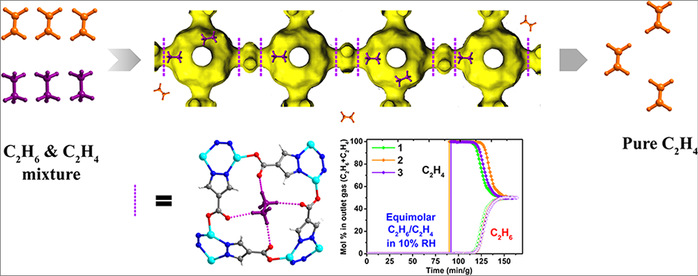
Heng Zeng,† Xiao-Jing Xie,† Mo Xie, Yong-Liang Huang, Dong Luo, Ting Wang, Yifang Zhao, Weigang Lu,* and Dan Li*

Abstract: Metal-organic frameworks (MOFs) with open metal sites (OMSs) have been shown to preferentially adsorb unsaturated hydrocarbons such as C2H4 due to the formation of π-complexation. However, the adsorption capacity and selectivity might well be dampened under humid conditions because OMSs could be easily poisoned in the presence of water vapor. C2H6-selective adsorbents with less hydrophilic environments, on the other hand, not only could effectively minimize the impact of humidity on separation capacity but also could directly produce high-purity C2H4 from C2H6/C2H4 mixtures. Here, we report a C2H6-selective MOF (JNU-2) underlying a rare xae topology. Its cage-like cavities are interconnected through apertures with a limiting diameter of ca. 3.7 Å, which is in the domain of kinetic diameters of C2H4 and C2H6 molecules. Molecular modeling studies suggest the four oxygen atoms on aperture are poised to preferentially interact with C2H6 through multiple C−H···O hydrogen bonding, rendering JNU-2 an enhanced C2H6 selectivity. Indeed, experimental results reveal that JNU-2 not only takes up a great amount of C2H6 comparable to other top-performing C2H6-selective MOFs but also displays excellent separation capacity even under humid conditions; moreover, it can be easily regenerated at room temperature owing to its moderate adsorption enthalpy. This work successfully demonstrated a strategy of balancing adsorption capacity and selectivity for C2H6 by designing MOF materials with cavities interconnected through tailored apertures. The apertures function as screening sites for C2H6 selectivity, while the internal cavities provide space for large adsorption.
文章链接:![]() J Am Chem Soc 2019 20390.pdf
J Am Chem Soc 2019 20390.pdf




